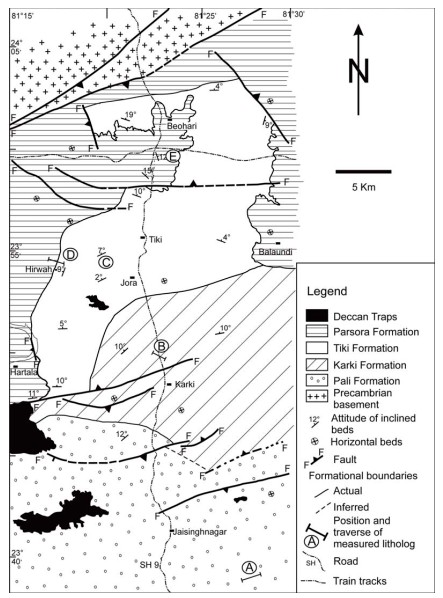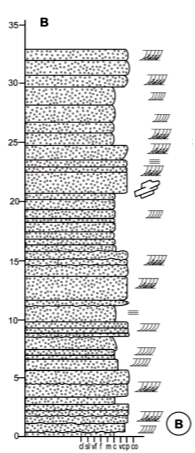Karki Fm
Type Locality and Naming
South Rewa Basin: Mukherjee et al. (2012) identified three mappable lithostratigraphic units below the Parsora Formation in South Rewa Basin instead of two (Pali Fm and Tiki Fm) identified earlier. The multistoried sandstone body conformably overlying the Pali Fm and measuring about 300 m near the village Karki (23°48 ́31"N: 81°23 ́30"E) has been named as the Karki Formation by Mukherjee et al. (2012). [Original Publication: Mukherjee, D., Ray, S., Chandra, S., Pal, S. & Bandyopadhyay, 2012. Upper Gondwana succession of the Rewa Basin, India: Understanding the interrelationship of lithologic and stratigraphic Variables. Jour. Geol. Soc. India 79: 563-575.]
[Figure 1: Geological map Pali-Birsinghpur area showing the location measured lithostratigraphic section (B) (after Mukherjee et al., 2012)]
Synonyms: Pali beds of Hughes (1881), Daigaon Stage (Lele, 1964), Pali Formation of Sastry et al. (1977).
Lithology and Thickness
Sandstone. There are two distinct types of sand bodies in the Karki Formation (Mukherjee et al., 2012). One is quartz arenite, coarse to very coarse grained with occasional coarse pebbles. These are ribbon-shaped, lack interbedded mudstone and/or shale, and exhibit medium to large scale trough cross-beddings. The second type of sandstones are pinkish-gray to light brown in color, multistoried, multilateral, arkosic, poorly sorted and contain abundant subrounded to subangular pebble to gravel-sized quartz, feldspar and chert grains. They exhibit large trough and planar cross-beds with pebbles arranged along the foresets. In the latter sandstone, petrified wood fossils are found to be common (Mukherjee et al., 2012). Absence of fine clastics differentiate this formation from that of the underlying Pali Fm and overlying Tiki Fm.
[Figure 2A,B: Field photographs of amalgamated multisoried sand bodies (A) and coarse grained sandstone with pebbles of quartz, chert, K-feldspar and wood fragments (B) in the Karki Formation exposed in Pali-Birsinghpur area (Mukherjee et al., 2012)]
[Figure 3: Measured litholog of the Karki Formation along the traverse B in the geological map (after Mukherjee et al., 2012)]
Relationships and Distribution
Lower contact
The Karki Formation has a gradational contact with the underlying Pali Fm.
Upper contact
The Karki Formation has a sharp contact with the overlying Tiki Fm (Mukherjee et al. (2012)
Regional extent
South Rewa Basin: Occurs in an area of about 1370 sq-km between latitude 23°39' N and 24°08' N, and longitude 81°15' E and 81°30' E.
GeoJSON
Fossils
As such no fossils have been documented by Mukherjee et al. (2012) from this formation except for wood fragments. According to them the Karkati floral assemblage containing abundant Glossopteris, along with Taeneopteris, Thinnfeldia and Pterophyllum from the Pali Fm indicate an age younger than the Raniganj Fm and equivalent to the Early Triassic Panchet Fm of the Damodar basin (Vimal and Singh 1968). Being sandwiched between the Lower Triassic Pali and Upper Triassic Tiki deposits, the Karkati Formation may represent Middle Triassic in age.
Age
Depositional setting
The Karki Formation was deposited possibly deposited by braided river system as attested by the amalgamated nature of the multistoried and multilateral sand bodies, high stacking density, and coarse-grained nature of the sediments. It was also inferred that the gradient of the Karki river bed was much steeper that that of Pali as there are no fine clastics in the Karki Formation (Mukherjee et al., 2012).
Additional Information
References
Hughes, T.W.H., 1881. Notes on the South Rewa Gondwana Basin. Records of Geological Survey of lndia 14, 126 -138. Lele, K.M., 1964. The problem of Middle Gondwana of India. Proceedings of the 22tld International Geological Congress, New Delhi, Session IX Gondwana, New Delhi: 181-202. Mukherjee, D., Ray, S., Chandra, S., Pal, S., Bandyopadhyay, S., 2012. Upper Gondwana Succession of the Rewa Basin, India: Understanding the Interrelationship of Lithologic and Stratigraphic Variables. Journal Geological Society of India, 79, 563-575 Sastry, M.V.A., Acharyya, S.K., Shah, S.C., Satsangi, P.P., Ghosh, S.C., Raha, P.K., Singh, G., Ghosh, R.N., 1977. Stratigraphic lexicon of Gondwana formations of India. Geol. Surv. India, Misc. Publ. 36, 1-170. Vimal, K.P. and Singh, S.N. (1968). Plant fossils from Karkati in the South Rewa Gondwana basin, India. Jour. Palaeont. Soc. India, 5, 34-38.

.jpg)
